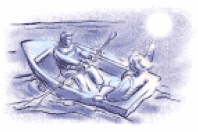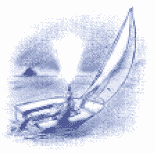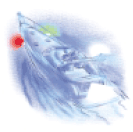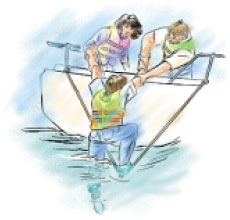Canadian Safe Boating Course
Chapter 3: Water Rescue Equipment
Minimum Equipment Required on Board Vessels
The Canadian Small Vessels Regulations and
the International Regulations for preventing
collisions (amended for Canada) require all
boats to carry a minimum of safety equipment.
The size of the pleasure craft determines the
equipment required.
Sailboards
Personal Protective Equipment:
- One Canadian-approved personal flotation
device or life jacket of appropriate size
for each person on board
- one buoyant heaving line of not less
than 15m in length. (This
equipment is not mandatory if all people on
the sailboard are wearing a Canadian-
approved flotation device of appropriate
size or engaged in an official competition
).
Boat Safety Equipment:
- one manual propelling device.
(This equipment is not
mandatory if all people on the sailboard are
wearing a Canadian- approved flotation
device of appropriate size or engaged in an
official competition ).
Distress Equipment:
- a watertight flashlight or 3 Canadian
approved flares of Type A,B or C.
(This equipment is not mandatory if all
people on the sailboard are wearing a
Canadian- approved flotation device of
appropriate size or engaged in an official
competition ).
Navigation Equipment:
- a sound signaling device or a sound
signaling appliance
Paddle boats and Water cycles
Personal Protective Equipment:
- One Canadian-approved personal flotation
device or life jacket of appropriate size
for each person on board
- one buoyant heaving line of not less
than 15m in length. (This
equipment is not mandatory if all people on
board are wearing a Canadian-approved
flotation device of appropriate size).

Distress Equipment:
- a watertight flashlight or 3 Canadian
approved flares of Type A,B or C. (This
equipment is not mandatory if all people on
board are wearing a Canadian-approved
flotation device of appropriate size).
Navigation Equipment:
- a sound signaling device or a sound
signaling appliance
- navigation lights that meet the
applicable standards set out in the
Collision Regulations if the pleasure craft
is operated after sunset and before sunrise
or in periods of restricted visibility.
Canoes, Kayaks, Rowboats and Rowing shells
Personal Protective Equipment:
- One Government of Canada (Department of
Transport) approved personal flotation
device (PFD) or a life jacket for small
vessels of appropriate size for each person
on board
- One buoyant heaving line of not less
than 15m in length

Boat Safety Equipment:
- One manual propelling device (paddle or
oars) OR an anchor with not less than
15m of cable, rope or chain in any
combination
- One bailer or manual water pump fitted
with or accompanied by sufficient hose to
enable a person using the pump to pump water
from the bilge of the vessel over the side
of the vessel
Navigation Equipment:
- A sound signaling device or a sound
signaling appliance audible at distances of
one-half a marine mile (0.93 km)
- Navigation lights that meet the
applicable standards set out in the
Collision Regulations if the pleasure craft
is operated after sunset and before sunrise
or in periods of restricted visibility.
Unpowered Pleasure Craft not over 6m in length
Personal Protective Equipment:
- One Government of Canada (Department of
Transport) approved personal flotation
device (PFD) or a life jacket for small
vessels of appropriate size for each person
on board
- One buoyant heaving line of not less
than 15m in length

Boat Safety Equipment:
- One manual propelling device (paddle or
oars) OR an anchor with not less than
15m of cable, rope or chain in any
combination
- One Class 5BC fire extinguisher .. ( IF
.. the craft is equipped with a fuel burning
cooking, heating or refrigerating
appliance).
- One bailer or manual water pump fitted
with or accompanied by sufficient hose to
enable a person using the pump to pump water
from the bilge of the vessel over the side
of the vessel. (This
equipment is not required for any
self-bailing sealed hull sailing vessel
fitted with a recess-type cockpit that
cannot contain a sufficient quantity of
water to make the vessel capsize or a
multi-hull vessel that has subdivided
multiple-sealed hull construction).
Navigation Equipment:
- A sound signaling device or a sound
signaling appliance audible at distances of
one-half a marine mile (0.93 km)
- Navigation lights that meet the
applicable standards set out in the
Collision Regulations if the pleasure craft
is operated after sunset and before sunrise
or in periods of restricted visibility.
Personal Watercraft (P.W.C.)
Personal Protective Equipment:
- One Government of Canada (Department of
Transport) approved personal flotation
device (PFD) or a life jacket for small
vessels of appropriate size for each person
on board
- One buoyant heaving line of not less
than 15m in length
Boat Safety Equipment:
- One manual propelling device (paddle or
oars) OR an anchor with not less than
15m of cable, rope or chain in any
combination. (This
equipment is not mandatory if all people on
the Personal Watercraft are wearing a
Canadian-approved flotation device of
appropriate size).
- One bailer or manual water pump fitted
with or accompanied by sufficient hose to
enable a person using the pump to pump water
from the bilge of the vessel over the side
of the vessel. (This
equipment is not mandatory if all people on
the Personal Watercraft are wearing a
Canadian-approved flotation device of
appropriate size).
- One Class 5BC fire extinguisher.
(This equipment is not
mandatory if all people on the Personal
Watercraft are wearing a Canadian-approved
flotation device of appropriate size).
Distress Equipment:
- A watertight flashlight or 3 Canadian
approved flares of type A,B or C
Navigation Equipment:
- A sound signaling device or a sound
signaling appliance audible at distances of
one-half a marine mile (0.93 km)
The Canadian Coast Guard and P.W.C.
manufacturers strongly advise against operating
this type of craft at night.
Not over 6m Powered
Personal Protective Equipment:
- One Government of Canada (Department of
Transport) approved personal flotation
device (PFD) or a life jacket for small
vessels of appropriate size for each person
on board
- One buoyant heaving line of not less
than 15m in length

Boat Safety Equipment:
- One manual propelling device (paddle or
oars) OR an anchor with not less than
15m of cable, rope or chain in any
combination
- One Class 5BC fire extinguisher
(if the craft is equipped
with an inboard engine, a fixed fuel tank of
any size, or a fuel burning cooking, heating
or refrigerating appliance).
- One bailer or one manual water pump
fitted with sufficient hose to enable one
person using the pump to pump water from the
bilge of the vessel over the side of the
vessel. (A bailer or manual water pump is
not required for any multi-hull vessel that
has subdivided multiple-sealed hull
construction.)
Distress Equipment:
- A watertight flashlight or 3 Canadian
approved flares of type A,B or C
Navigation Equipment:
- A sound signaling device or a sound
signaling appliance audible at distances of
one-half a marine mile (0.93 km)
- Navigation lights that meet the
applicable standards set out in the
Collision Regulations if the pleasure craft
is operated after sunset and before sunrise
or in periods of restricted visibility.
Vessels over 6m but not over 8m
Personal Protective Equipment:
- One Government of Canada (Department of
Transport) approved personal flotation
device (PFD) or a life jacket for small
vessels of appropriate size for each person
on board
- One buoyant heaving line of not less
than 15m in length or one approved life
buoys with an outside diameter of 610 mm or
762 mm that is attached to a buoyant line of
not less than 15m in length
- a re-boarding device if the freeboard of
the vessel is greater than 0.5 m

Boat Safety Equipment:
- One manual propelling device (paddle or
oars) OR an anchor with not less than
15m of cable, rope or chain in any
combination
- One bailer or manual water pump fitted
with or accompanied by sufficient hose to
enable a person using the pump to pump water
from the bilge of the vessel over the side
of the vessel
- One Class 5BC fire extinguisher, if the
pleasure craft is a power driven vessel,
plus another class 5BC fire extinguisher if
the pleasure craft is equipped with a fuel
burning cooking, heating or refrigerating
appliance
Distress Equipment:
Navigation Equipment:
- a sound signaling device or a sound
signaling appliance
- navigation lights that meet the
applicable standards set out in the
Collision Regulations if the pleasure craft
is operated after sunset and before sunrise
or in periods of restricted visibility
Vessels over 8m but not over 12m
Personal Protective Equipment:
- One Government of Canada (Department of
Transport) approved personal flotation
device (PFD) or a life jacket for small
vessels of appropriate size for each person
on board
- One buoyant heaving line of not less
than 15m in length
- One approved life buoys with an outside
diameter of 610 mm or 762 mm that is
attached to a buoyant line of not less than
15m in length
- a re-boarding device if the freeboard of
the vessel is greater than 0.5

Boat Safety Equipment:
- An anchor with not less than 30m of
cable, rope or chain in any combination
- One bailer
- One manual water pump fitted with or
accompanied by sufficient hose to enable a
person using the pump to pump water from the
bilge of the vessel over the side of the
vessel
- One Class 10BC fire extinguisher, if the
pleasure craft is a power driven vessel,
plus another class 10BC fire extinguisher if
the pleasure craft is equipped with a fuel
burning cooking, heating or refrigerating
appliance
Distress Equipment:
- a watertight flashlight
- 12 Canadian approved flares of Type A,
B, C, or D (not more than 6 can be Class D)
You are exempt from carrying pyrotechnic
distress signals if:
- operating in a river, canal or lake in
which it can at no time be more than one
mile from shore OR
- engaged in an official competition or in
final preparation for an official
competition and has no sleeping
arrangements.
Navigation Equipment:
- a sound signaling device or a sound
signaling appliance
- navigation lights that meet the
applicable standards set out in the
Collision Regulations
Vessels over 12m but not over 20m
Personal Protective Equipment:
- One Government of Canada (Department of
Transport) approved personal flotation
device (PFD) or a life jacket for small
vessels of appropriate size for each person
on board
- One buoyant heaving line of not less
than 15m in length
- One approved life buoys with an outside
diameter of 610 mm or 762 mm that is
equipped with a self-igniting light and is
attached to a buoyant line of not less than
15m in length
- a re-boarding device

Boat Safety Equipment:
- An anchor with not less than 50m of
cable, rope or chain in any combination
- bilge pumping arrangements
- One Class 10BC fire extinguisher at each
of the following locations:
- at each access to any space where a
fuel burning cooking, heating or
refrigerating appliance is fitted
- at the entrance to any accommodation
space
- at the entrance to the engine room
space
- one axe
- Two buckets, each with a capacity of 10
litres or more.
Distress Equipment:
- a watertight flashlight
- 12 Canadian approved flares of Type
A,BC, or D (not more than 6 can be Class D)
Navigation Equipment:
- Two sound signaling appliances (bell and
whistle)
- Navigation lights that meet the
applicable standards set out in the
Collision Regulations
Vessels over over 20m
Personal Protective Equipment:
- one personal flotation device or life
jacket of appropriate size for each person
on board
- one buoyant heaving line of not less
than 30 metres in length
- two life buoys, each of which has an
outside diameter of 762 mm. and is attached
to a buoyant heaving line of not less than
30 metres in length, and one of which is
equipped with a self-igniting light
- a lifting harness with appropriate
rigging
- a re-boarding device

Boat Safety Equipment:
- an anchor with not less than 50 metres
of cable, rope or chain in any combination
- bilge-pumping arrangements
- one power-driven fire pump located
outside the machinery space, with one fire
hose and nozzle whereby a jet of water can
be directed into any part of the pleasure
craft
- one Class 10BC fire extinguisher at each
of the following locations:
- at each access to any space where a
fuel-burning cooking, heating or
refrigerating appliance is fitted
- at the entrance to any accommodation
space
- at the entrance to the engine room
space
- two axes
- four buckets, each with a capacity of 10
litres or more
Distress Equipment:
- a watertight flashlight
- 12 Canadian approved flares of Type
A,BC, or D (not more than 6 can be Class D)
Navigation Equipment:
- Two sound signaling appliances, as
specified in the Collision Regulations
- Navigation lights that meet the
applicable standards set out in the
Collision Regulations
Additional Recommended Equipment
For all boats, the above equipment is
obviously the minimum required. To effectively
respond to a boating incident, the following
additional items of equipment should be carried
on board:
Emergency Kit:
- Pyrotechnic distress signals; There are
four types of distress signals:
- rocket parachute flares,
- star rockets or shells which throw
stars one or two at a time,
- hand flares (limited visibility
because they are at water level)
- smoke flares (flares giving off
orange smoke .. only effective during
daylight).
- First aid kit;
- Repair kit (see section 2.1);
- One life buoy with 15m buoyant heaving
line
- Two blankets
- One flutter board
 Make
sure that you have a method or equipment to get
a person who is in the water, back onto your
boat.
Make
sure that you have a method or equipment to get
a person who is in the water, back onto your
boat.
Consideration should be given as to how this
will work if the person has sustained injuries
As required, other equipment could be added
to this basic material, including a pole, a
communications system, etc. (or a magnetic
compass to assist the operator in determining
direction, although the operator must be aware
of any nearby metallic or electrical devices
which are likely to distort the readings).
Equipment Maintenance and Storage
A properly equipped boat will be of little
use if the materials on board are unusable
because of breakage or early wear and tear.
Maintaining and storing equipment not only
makes sense aesthetically and economically, but
the safety of boaters and the safety of their
passengers depends on it.
Flotation Devices
There are two main types of flotation
devices: life jackets and personal flotation
devices (PFD). PFD's are increasingly popular
because they are designed for comfort and
thermal protection. As a rule, the more body
surface covered by the PFD, the better its
thermal protection. PFD's exist in vest and
suit form. Although more expensive than life
jackets, PFD's offer better protection, more
comfort and more elegance.
PFD's and/or life jackets approved status
will become void if they have been repaired or
altered. Do not dry PFD's in sunlight.
Note: Never use your PFD or life
jacket as a fender or a cushion; damaging them
voids their approved status.
PFD’S and/or life jackets must fit snugly
while allowing free movement of legs and arms.
Approval:
In Canada, PFD's and life jackets are
approved by the Canadian Department of
Transport. Devices approved by the US government
or the US Coast Guard are not Government of
Canada-approved. (If it is a foreign vessel then
the rules applied are the rules of their home
country)
Colour:
Only red, yellow or orange life jackets meet
Government of Canada standards. PFD’s however,
come in a wide variety of styles and colours.
| |
Life jackets |
Personal Floatation Devices
|
| Behavior
in water |
- Once a
person is immersed, it keeps
face out of the water and
tilts the body slightly
backward
|
- allows
persons to float comfortably
with their face out of the
water
|
Appropriate for
which boats? |
- All
pleasure craft and some
commercial vessels
|
|
| Sizes |
- up to 18
kg. (40 lb)
- 18 to 40
kg. (40 - 90)
- Over 40
kg. (90 lb)
|
- Various
sizes, depending on chest
measurement and weight
|
| Models |
|
- Over 120
approved models available in
Canada
|
|
Advantages |
-
Reversible
- High
buoyancy
-
Affordable
- Ensures
face-up position in cases of
unconsciousness
|
-
Adjustable
- Versatile
and elegant
- Freedom
of movement
-
Protection against effects
of cold water
-
Accessories: pockets, hood,
harnesses
|
|
Disadvantages |
- More
uncomfortable (which is why
people often don’t wear
them)
- Poor
protection from effects of
cold water
- Require
careful maintenance
- Less
effective if wrong size or
improperly fastened
|
- More
expensive than a life jacket
- less
effective in rolling over
unconscious victim
- less
buoyant than a life jacket
|
Materials
Kapok:
Kapok, often used to manufacture life jackets
and cushions, is contained in vinyl coverings
which are easily punctured. Kapok deteriorates
quickly and loses its buoyancy. Kapok can
support 25 times its weight.
Single-cell foam:
Polyethylene and airex are two very common
types of foam. Foam is a very long-lasting
buoyant material.
Maintenance
Regularly check that life jackets or PFD's
are still properly buoyant. The foam should not
be too rigid. Kapok sacks must be light, soft to
the touch and puncture-free.
Life jackets and PFD's should be worn on
board. They should not be used for kneeling,
sitting or as a fender.
When wet, rinse flotation gear in fresh water
and hang to dry in the open air or a
well-ventilated location. Do not expose them to
direct heat.
Store life jackets and PFD's in a cool,
well-ventilated area.
Clean with mild soap and water. Strong
detergents, dry cleaning and petroleum products
can damage flotation gear.
Positive Attitudes
Caution and foresight in regard to equipment
means:
Caution and foresight
- Wear a personal flotation device at all
times;
- Handle your equipment with care;
- Obey safety rules concerning fuel and
oil tanks;
- Properly maintain and store your boat
and its cargo.
Be aware of effects: waves, sounds,
coordination and reflexes.
Use of Safety Equipment and Requirement to
Inform persons on board
- Wear a personal flotation device. The
technique for putting on personal flotation
devices in the water should include the
following steps:
- Spread the device open with the
inside facing up out of the water,
- Rotate the device so as to look at
the neck opening,
- Extend both arms through arm
openings;
- Lift arms over the head;
- Fasten the device to fit snugly.
- As a safety measure, the operator of a
pleasure craft should read the
manufacturer’s instructions before using
pyrotechnic distress signals, and check the
expiry date.
It is important to note that the
“pyrotechnic distress signals” to be carried
on board a pleasure craft must be approved
by the Department of Transport Canada, in
accordance with the Small Vessels
Regulations, Material Standards -
Pyrotechnic Distress Signals.
- As well, the operator should locate the
required safety equipment in readily
accessible places on board the craft.
- The operator of a pleasure craft should
inform the persons on board about the
following safety points:
- The location of personal flotation
devices and/or life jackets;
- The techniques for putting on
personal flotation devices and/or life
jackets;
- The techniques for putting on
personal flotation devices and/or life
jackets when in the water;
- The importance of wearing personal
flotation devices and/or life jackets at
all times;
- The location of the emergency kit;
- The importance of keeping oneself
low, on the centre line, and holding on
to a rigid part of the pleasure craft
while moving around on board;
- The importance of keeping one’s
hands, arms and legs inside the pleasure
craft when approaching or leaving a
dock;
- The effects of the motion of the
pleasure craft, sunlight, waves, wind,
sound and alcohol on them; and
- Their roles in the event of
emergencies.
Responding to hull leaks or flooding.
The following actions should be taken in
response to a hull leak or flooding such as when
water is seen to be rising in the pleasure craft
or accumulating at the bottom of the craft:
- Locate the source of the hull leak or
the flooding.
- Stop the leakage or the source of
flooding if possible;
- Remove accumulations of water in the
hold or other compartments of the pleasure
craft by incorporating either hand-held
bailer’s, manual pumps or bilge pumping
systems as appropriate to the circumstances
and to the craft; and
- Use or exhibit signals to indicate
distress and need of assistance if
necessary.
The operator of a pleasure craft should carry
on board at all times tools and materials to
temporarily stop hull leaks or flooding.
Responding to capsizing, swamping, sinking
and grounding.
The following actions should be taken in
response to a pleasure craft that capsizes, that
swamps, that sinks or that runs aground:
- Don personal flotation devices or life
jackets
- Stay with the craft when appropriate;
- Account for persons previously on board;
and
- Use or exhibit signals to indicate
distress and need of assistance if
necessary.
Responding to cold water immersion or wind
chill
- “Hypothermia” is a drop in body
temperature below the normal level that most
frequently develops from exposure to
abnormally low temperatures such as:
- Immersion in cold water
- Exposure to cool air in water-soaked
clothing, or
- Prolonged exposure to low
environmental temperatures
- The following signs and symptoms
represent the impact on the mental and
muscle functions of the persons exposed to
hypothermia as it progresses:
- Shivering and slurred speech,
conscious but withdrawn at the early
stage;
- Slow and weak pulse, slow
respiration, lacks coordination,
irrational, confused and sleepy at
intermediate stage;
- Weak, irregular or absent pulse or
respiration, loss of consciousness at
final stage.
- The following actions should be taken in
the presence of a person found to be
suffering from hypothermia:
- Remove the person from the source of
cold exposure;
- Provide dry shelter;
- If possible, prevent further
decrease in body temperature and warm
the person’s body gradually by:
- Replacing wet clothing with dry
clothing,
- Wrapping the person in blankets,
- Placing dry coverings over the
person,
- Covering the person’s head and
neck,
- Covering the person with an
insulating device and vapour
barrier;
- Applying warm dry objects (40 to
45C).
- If asked for, offer warm liquids but
do not give alcohol or hot stimulants to
the person;
- Do not rub or massage the surface of
the person’s body or extremities;
- and Use or exhibit signals to
indicate distress and need of assistance
if necessary.
- While wearing personal flotation devices
or life jackets, some positions can help
persons to survive longer when immersed in
cold water:
- If alone, adopt a “fetal position”
by crossing arms tightly against the
chest and by drawing the knees up close
to the chest (heat escape lessening
position);
- If alone, climb onto a nearby
floating object to get as much of the
body out of/or above the water
- If in a group, “huddle” with other
persons by getting the sides of
everyone’s chest close together with
arms around mid to lower back and legs
intertwined.
- The following may provide additional
protection to a person’s body from
hypothermia:
- dry suit
- wet suit
- immersion suit
- survival suit
- exposure coverall
- multiple light layers of dry
clothing,
- water or wind proof outer layer
Know the following technique to test
personal flotation devices and/or life jackets
- while wearing the personal flotation
device and/or life jacket,
- in chest-deep water,
- the person shall bend the knees,
- then float on the back, and
- shall make sure that the personal
flotation device and/or life jacket keeps
the chin above water so that it is easy to
breathe.